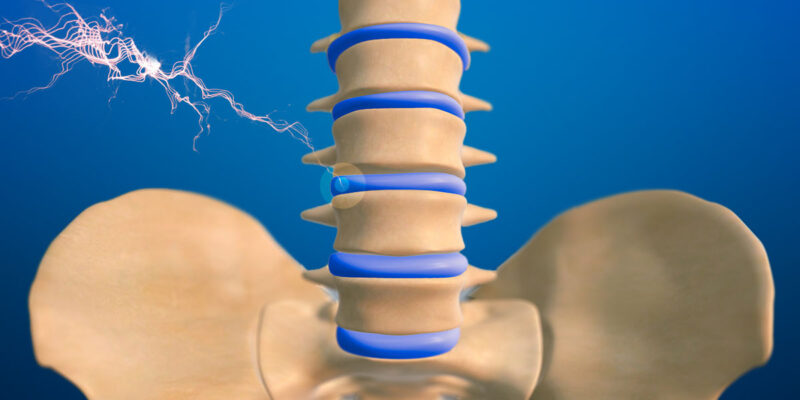

The human spine is a complicated structure that combines bones, spinal discs, muscles, nerves and more. When people experience back pain, there can be many reasons for it. For example, compressed nerves, weak core muscles or spinal disc degeneration can all cause back pain.
To find the best treatment for back pain, you need to first determine the cause of your pain. Seeing a doctor will help you eliminate potential causes so you can properly treat the root of your pain. The best option for you may depend on several factors.
If you’re experiencing pain in your lower back, one possible cause is lumbar degenerative disc disease. Degenerative discs can create inflammation in your bones, causing nerve pain. Thankfully, an intracept procedure offers a minimally invasive way to reduce this kind of pain.
Spinal discs are located between each bone in your spinal column. They resemble jelly donuts, having a round shape with a liquid center. When discs are healthy, they provide a cushion that absorbs impact and keeps bones from rubbing against each other as you move.
Healthy discs create space in your back for nerves to run through and around your spinal column. When discs begin to degenerate, they can impact the surrounding bones, muscles and nerves. Degeneration happens when the liquid in the center starts to dry up and the disc flattens out.
Bulging or flattened discs can compress nerves, leading to sciatic pain that radiates down your leg and foot. Because discs cushion bones, degenerative discs can also create pain by allowing bones to rub together and become inflamed. The ends of your vertebrae are called endplates, and they often experience the brunt of this kind of damage.
Although everyone experiences disc degeneration as they age, not everyone experiences pain. Disc degeneration causes a loss of height between each vertebra as discs become more flat. For some people, degenerative discs can cause a lot of pain and reduced mobility.
Here are several signs that you might be experiencing degenerative discs in your lower back:
When discs become damaged, the endplates of your vertebrae can as well. Although it may come as a surprise, your bones actually have nerves inside them as well as around them. Your endplates are full of nerves, and your body may experience increased pain signals through these nerves.
The primary nerve that runs through your vertebrae is called the basivertebral nerve. Patients who have damaged endplates often experience pain because this nerve is telling the brain something is wrong. Unfortunately, this can lead to chronic lower back pain, also known as vertebrogenic pain.
An intracept procedure is designed to turn off the pain signals coming from your basivertebral nerve. Because it’s minimally invasive, patients who receive this procedure recover quickly. According to a 2020 study, they also have good long-term outcomes for pain reduction after the surgery:
Many patients with lower back pain have disc degeneration and inflammation between their L5 vertebrae and sacrum bone. There are some surgical procedures that can replace this disc to reduce friction and create more space for your nerves.
If your vertebrae are compressing nerves, replacement disc surgery may be the best choice for you. However, these surgeries have a long recovery time. If your pain is being caused by nerves inside your vertebrae, caused by damaged and inflamed endplates, an intracept procedure may be the best solution.
During an intracept procedure, patients lay on their stomachs and are sedated so they don’t experience any pain. Once surgery prep is complete, medical staff create a small incision in the lower back near the source of pain in the spine.
A medical tool called a cannula — similar to a metal straw — is inserted. Next, a medical instrument is fitted through the cannula and into the bone until it reaches the exact spot where the nerves are signaling pain.
Next, a radiofrequency probe is run through the medical instrument so that it can apply heat directly to the nerve. This controlled heat “ablates,” or removes, the specific targeted nerve so that it can’t cause pain anymore.
After surgery, patients can expect some discomfort and pain as their body heals. However, pain should be minimal and easily managed with medication. Although a patient’s back may be sore around the incision, pain radiating from the spine should decrease significantly.
If pain does not decrease, then the basivertebral nerve targeted by the surgery wasn’t the cause of your lower back pain. It may also be that your pain is being caused by multiple factors — in that case, the surgery will help but may not completely eliminate pain.
There are many benefits to a minimally invasive surgery like an intracept procedure. Here are just a few things to consider:
Although minimally invasive surgeries have many benefits, only a physician can determine the best care plan for managing your pain. Before you consider any kind of surgery, you should explore noninvasive options with your doctor. Here are a few changes that can help reduce back pain:
If none of these practices are making a difference for you, your physician may recommend surgery. Sometimes, a combination of different lifestyle changes and treatments is needed to completely reduce pain. It’s important to stay hopeful and try a new treatment for lower back pain if your initial options don’t make a difference.
Are you experiencing back pain? At the New York Spine Institute, we offer diagnosis and care for a range of spinal issues, including but not limited to:
Reach out to us today for more information on how we can help you reduce your pain. Spinal pain can be debilitating, but it doesn’t have to stop you from enjoying your life. Our number one goal is to improve the quality of life for patients experiencing chronic pain.